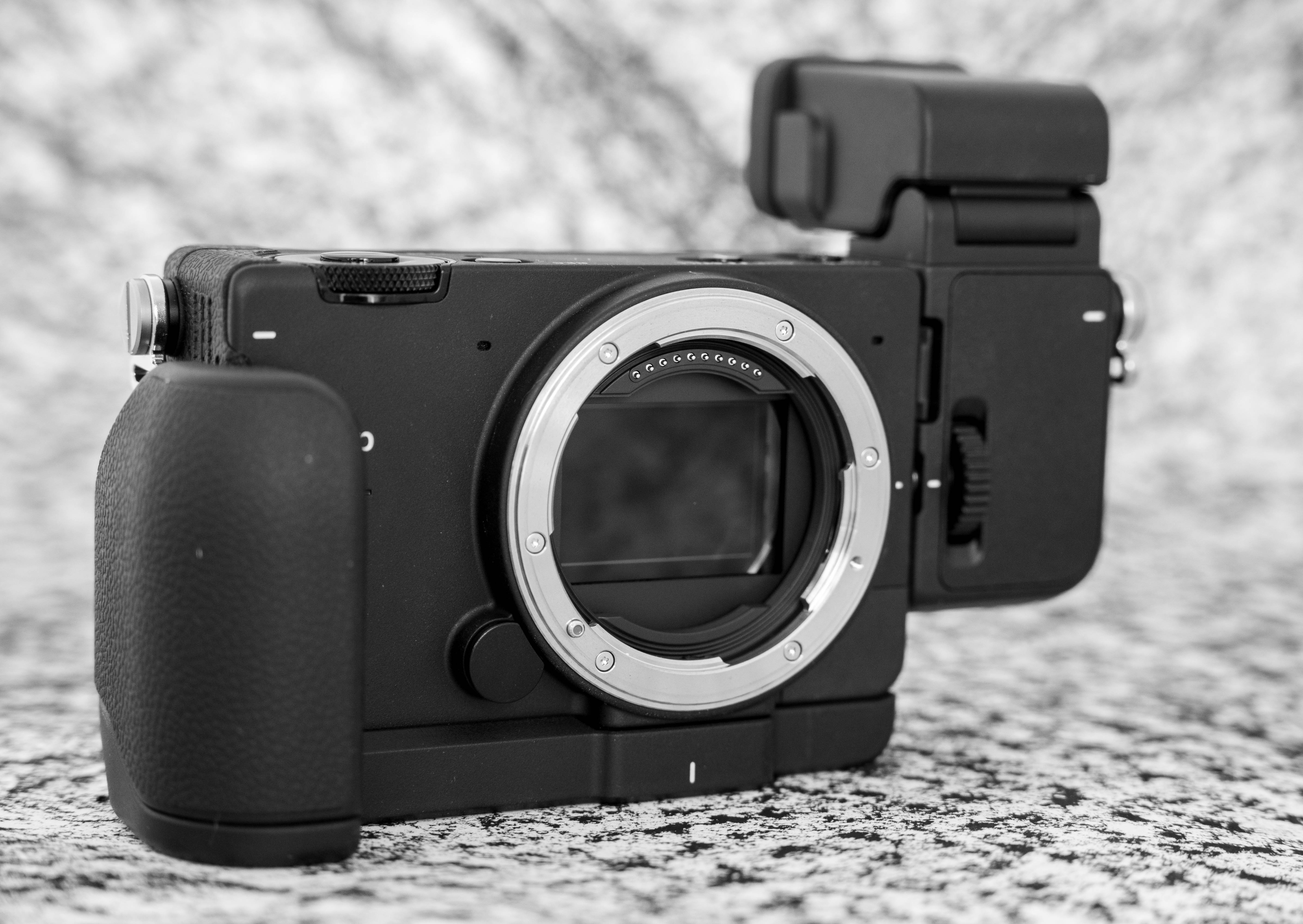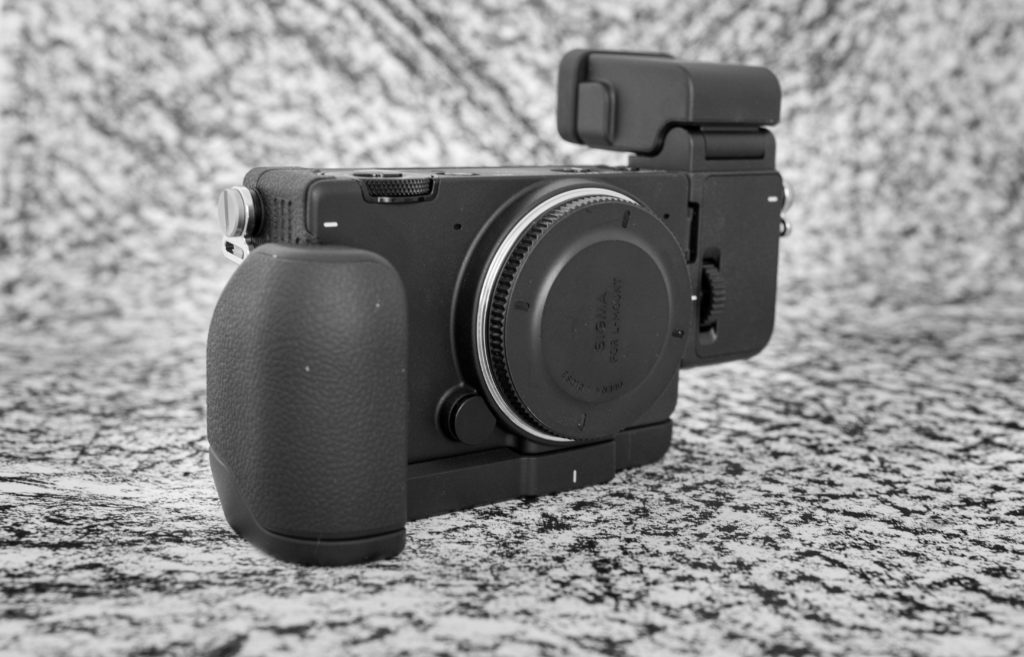An instinctive reaction to a camera happens quickly. Snap a dozen pictures. Adjust a few settings. Find your groove and edit the results. Within this timeframe, a camera’s best features usually present themselves relatively quickly. After the first day, I knew the Sigma fp L could be an incredible street camera for any photographer. Once the photographer adjusts to a few unique settings and features, they can be off on their merry-photography way.
The Sigma fp L comes with a full-frame 61 MP sensor. For the $2499 price tag, the 61 MP sensor is an incredible deal. As I took photo after photo during my review, I could tell the Sigma fp L’s sensor could deliver stunningly clear images with decent dynamic range. Let me say 61 MP is entirely something to see in person. The level of deep detail in the raw photos is pretty astounding to see in LightRoom or Photoshop.
During my review timeframe with the Sigma fp L my family and I found ourselves fostering a baby duck a neighbor found and dropped off. We named it “Fuzzy.” The photos taken of Fuzzy by the Sigma fp L reveal a deep detail to the soft down feathers of the week-old duckling. This is the kind of feature I like to see in a camera that boasts a 61MP sensor. Detail better than most means better wide shots and maybe even slightly easier to read, visually, high detail photos and art.
Taking pictures of a cuddly and quick duckling showed a Sigma fp L crack in the new camera and features. The continuous autofocus on the Sigma fp L was not fast enough to keep both my four-year-old daughter and week-old duckling in focus during action shots. I switched to manual with the zoom-in focus guide and found the easy-to-use focus settings and zoom-in for focus simple to use and quicker for the situation. But, the color and detail remained the defining memory I have from the duckling shoot session.
Interestingly, Sigma fp L uses SD cards, and with each viewing of a raw 9.5 photograph, the user must pause a second for the camera to load the full resolution preview image. Then, boom, clarity and resolution, and detail oozes off the rear LCD screen. Each moment of slight blur gave me a bit of pause because I felt like my images sucked but then relief set in when my decent speed SD card fed the camera the whole 9.5K image. If you decide to pick up the Sigma fp L, find the fastest SD cards you can afford.
Yet, this tiny, in fact, miniature camera built around a full-frame 61 MP sensor is a little befuddling. The small size is great for many situations, but we’re not living in a world with large mirrorless cameras hanging around all over. Small and slightly smaller is still tiny. Small is great until it isn’t. I mean to say that there seems to be a lack of a return on investment with going smaller and smaller with a camera body. I love seeing all the electronics made smaller and better engineered, which is a HUGE accomplishment. Yet, adding accessories to a tiny camera feels like putting a 20lb school bag on the back of a 40lb toddler; it looks like it’s about to fall over.
Great for landscapes
When I picked up the Sigma fp L, my first instinct was to shoot a scene that could benefit from the detail and clarity the Sigma can deliver, so I started my review with a bit of landscape photography. Nothing special, but a view special to me, my backyard on the edge of the Stones River.
The Sigma fp L shines within the world of landscape photography. Obviously, the sensor and its large pixel count fit the clarity one might want in their landscape photography. The small size and weight of the Sigma means a backpack full of camera gear might weigh a little bit less. Small changes in one’s hiking kit can lead to significant differences when hiking up and down trails all day.
Yet, being a gear head meant once I achieved a 61 MP or 9.5K image, I needed more, so I reached for my DJI Ronin S. The Ronin S and still-photography is a good match; the two together meant I could shoot panoramas or stitch together huge photos. I did both with impressive results. 9.5K turned into 60K of backyard resolution.
Street Photography
Why I think the Sigma fp L succeeds reasonably well as a landscape camera helps it with non-flash street photography. The resolution and detail seem made for wide, visually detailed shots—the more detail in the image, the better.
Let’s pause to talk about the size of the Sigma fp L and Sigma fp; both are the same size, which is small. Sigma fp L and Sigma fp do not have electronic viewfinders built into their bodies like a traditional mirrorless camera or DSLR. Still, Sigma offers an EVF accessory for the Sigma fp L.
To add an accessory to a tiny camera feels sacrilege to the small form factor. As my eyes age, I need a good viewfinder, so I gave a bit of side-eye to the Sigma accessory.
The placement for the EVF is on the left side of the camera. You take off one port cover and fold back the other to screw the accessory to the camera body. Over time, you will need to tighten the viewfinder down because the mount may become loose during use.
Using an electronic viewfinder mounted to the far left of a camera feels a little odd at first. Both hands end up to the right of your eye line, which feels a little out of place. It took me about a day to get used to the far left EVF. Once you get used to the left side EVF, if you do, then your hands will find the buttons you need.
The electronic viewfinder itself is decent: not the smallest or the biggest. The color felt accurate to the rear LCD screen, and the necessary information for exposure and other vital settings were easy to read. Can you ask more from an EVF?
My biggest beef with the left-side electronic viewfinder accessory is this: you lose the HDMI output. You can either monitor your image via EVF or HDMI, but you cannot use both. For video shooters, this is a downfall for the Sigma fp L. To look at a larger on-camera monitor then into an electronic viewfinder is a natural habit for me as a video shooter. This HDMI or EVF problem stems from what I think is an EVF designed after the camera body.
Should you shoot video on the Sigma fp L? Well, you can, but should you? I found the video functions to be a little lacking. Other camera systems may be able to offer more usable Autofocus settings. What the Sigma fp L delivers for still photography, it does not for video. Yet, this is kind of how Sigma frames the Sigma fp L. The Japanese company does not skirt from the fact the Sigma fp L is better for still photography than motion. In fact, when Sigma announced the Sigma fp L, they also announced improved video functions for the video-centric camera the Sigma fp, without the “L.”
Sigma fp L ISO range
Do you know what is great about a 61 MP sensor? If you have a full-rez image with noise, not many will see the image unless they look very closely. This Sigma fp L is not a low-light monster like a Sony A7s III. Yet, the small camera with a big resolution holds its own. I feel like we’re in a space where most cameras can shoot low-light situations pretty well. The Sigma fp L and its 61 MP sensor do more than hold their own.
Blocks the HDMI output
I want to reiterate that the EVF accessory blocks the HDMI output, which is a massive bummer for video shooters who wish for an EVF and an external monitor. It is an either-or situation with the Sigma fp L.
Battery life
I think my unscientific guess to battery life with the camera set to 9.5K and LCD screen as bright as it could go lasted a bit over an hour to an hour and a half with continuous use. I think most photographers may want to grab four to six batteries if they’re using the Sigma fp L for all-day event photography.
Media
If I were a betting man, I’d bet the reason Sigma went with SD cards for the Sigma fp L’s memory cards was cost. Keeping user costs down with manufacturing costs down is a win-win for everyone. I am sure that Sigma knows the Sigma fp L will not need the kind of memory card speed a Nikon D6 or Canon R3 might require.
L – mount
I like what Sigma, Leica, and Panasonic are doing with the L-Mount initiative. The three manufacturers combining their lens mounts into one that works across three different systems helps them to stay competitive with a powerhouse like Canon. By working together, they ensure their lenses and cameras can compete with other brands and allows the users to see their lens investments work across different camera systems.
Last Thoughts
The Sigma fp L is an interesting camera. On the one hand, it has a beautiful 61 MP sensor and all a high pixel count can deliver, and on the other hand, you have a unique camera user experience that is neither good nor bad; it just is unique. If you need and want 61 MP, then Sigma fp L is the best price. The image allows photographers to show off incredible detail with good color, which is what I am usually looking for in a camera.

